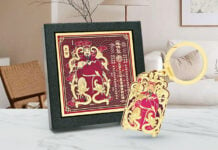In architectural lingo, the phrase Form & Function crops up a great deal. So what is Form & Feng Shui and how is this incorporated into house design? Form is usually symbolized by shape, which can also symbolize one of the five elements of feng shui. The water element for instance is wavy, metal is round, earth is square, fire is triangular and wood is rectangular. Shapes, colours and materials offer clues to the intrinsic elements underpinning houses and based on this, we can classify houses and buildings according to their element type. Here, feng shui trained architect Chris Yeo discusses the impact of element analysis on home feng shui.
 What type of element is good for my house?
What type of element is good for my house?
First, familiarize yourself with the productive and destructive cycles of the 5 elements and how they interact with each other. Determine the element of your house based on the sitting direction, then use shapes, forms and materials that compliment the element of the house to create good and harmonious feng shui.
It is possible to determine the facing and sitting direction of houses by using a compass to take direction. Each direction has an equivalent element. Thus South is fire, North is water, East & SE are wood, West and NW are metal, and NE and SW are earth.
Fire Houses
So, for example, if your house faces North, it sits South, making it a Fire house. Ideal design ideas would be to incorporate shapes and forms that are symbolized by the element. In this case, the use of a triangular pitched roof would help strengthen the Fire element of this house. Use of materials such as wood will help to fuel the strength and luck of the house further. Such houses would be excellent for those who benefit from fire and earth elements.
Water Houses
In this example of a South-facing water house, the concept of curved walls was introduced to accentuate the wave-like concept of the residence without creating too much deformity. Curved walls are introduced in a weave-like fashion to simulate the concept of waves interlocking with each other.
Colours can be introduced through the façade design with the use of blacks, blues and whites as complimentary elements to enhance the element of water. Whites represent metal, while blacks and blues symbolize water. Avoid any green colours or wood flooring, as wood energy here will exhaust the strength of the house (since wood exhausts water in the cycle of element) thus affecting its luck potential. This kind of house benefits those who need the water and wood element.
Metal Houses
Houses facing East or Southeast are considered to be Metal houses, as they sit West and Northwest respectively. Such houses can be designed with an array of options. One design option is to create a form that is curvaceous in nature, thus emphasizing the circular form or metal shape. The use of curves here takes on a smooth motion without any crisscrossing of lines throughout the façade. Colours that compliment such houses include your entire range of grays, whites and even earth tones. The element of earth can be further introduced through choice of flooring, where marble comes in a variety of beige tones to choose from. Such houses benefit people who need metal and earth elements.
Wood Houses
Any rectilinear-shaped home symbolizes a wood element home. So if your house is facing South and takes on such a shape, consider introducing curved forms on the façade through the roof lines or balcony to create a more wavelike form. But a house with this kind of shape is perfect for a house facing West or Northwest. In the scenario of a wood element home, the ideal choice of materials would be to use shingle roof tiles and wood flooring. Colour schemes can include the use of light green or blue hues to simulate the element wood and water energy within the household. Those who need wood or fire element energy will benefit from this house.
Earth Houses
The Northeast-Southwest orientation homes are the only homes able to both face and sit on the earth element directions. In this case, the most ideal house form is the square shape. Materials used should include earth-based marble, ceramic tiles or granite finishes. Colours for such houses should include beige earth colours with slight hints of red hues in certain areas. Avoid the use of greens or metallic finishes, as these elements will weaken the luck of the house. Those who need earth or metal elements will benefit from such homes.
So when it comes to achieving good feng shui, not only do we need to consider the effects of flying star charts and how they affect the internal room configurations of the house, it is also important to identify the shape and form that your house takes and to see how you can transform the look of your residence to be in sync with the intrinsic element of your house. Colours and materials to strengthen the luck of the house can also be considered when superimposing flying star charts to further enhance the luck of each of the individual sectors of the home.
Thus, if you have the luxury of building your house from the floor up, or if you have the budget to renovate, it is best to enhance the luck potential of your home or future home not just through flying star analysis, but also by identifying the element of your house and aspiring to achieve an architectural design that is in harmony with its element.
























